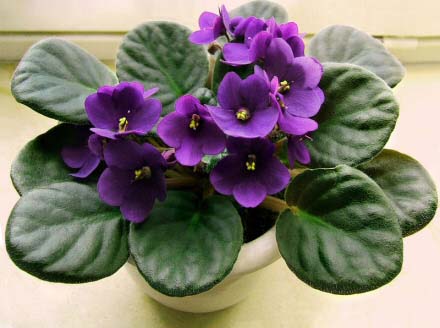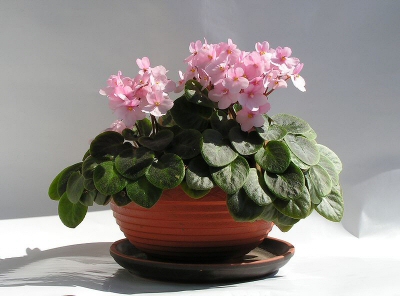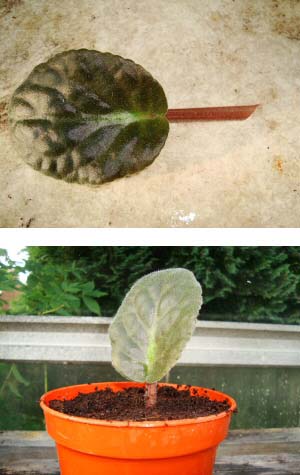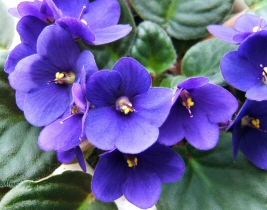





Saintpaulia is often know as an African Violet because it originates from Africa and the flowers look like violets (although they are  unrelated). The plant is a newish addition to our homes, only appearing in large numbers starting in America in the 1930's but has been loved ever since. The plant was discovered by Baron von Saint Paul in 1892 at which point it was sent to Hermann Wendland at Berlin's Royal Botanic Gardens, who named it Saintpaulia ionantha after Baron's family name.
unrelated). The plant is a newish addition to our homes, only appearing in large numbers starting in America in the 1930's but has been loved ever since. The plant was discovered by Baron von Saint Paul in 1892 at which point it was sent to Hermann Wendland at Berlin's Royal Botanic Gardens, who named it Saintpaulia ionantha after Baron's family name.
The original Saintpaulia was quite difficult to grow in homes and consequently didn't become popular. However around 1925 Armacost and Royston, a Los Angeles nursery, recognised the potential of the plant and started developing new cultivars. It wasn't long before they released their first creation named "blue boy", it was quite different to the older Saintpaulia because this variety was very easy to propagate, could deal quite happily with average home conditions and had a longer and more robust flowering period. The Americans loved it and from 1930 onwards it become increasingly desired.
The plant is steeped in a rich recent history but that doesn't make it old fashioned
Gradually more cultivars were created and cross-bred, as the years passed new colours and plants with different leaf shapes came to the market. African Violet's didn't become very popular in Europe until after the end of the Second World War at which point countries like United Kingdom became gripped throughout the 1960s and 1970s by, what was dubbed, African Violet fever. This was in part due to Dr David Hessayon and his best selling gardening books, that opened a door to show people that looking after houseplants like the African Violet was actually incredibly easy.
Many plants have their devoted fans, you just don't know about it because the majority aren't that vocal about it. The Saintpaulia fans though are a different kettle of fish,  they adore this plant and have a passionate desire to come together and share their experiences as well as help new amateur owners find their way. African Violet Societies have existed in many countries around the world since the end of the Second World War.
they adore this plant and have a passionate desire to come together and share their experiences as well as help new amateur owners find their way. African Violet Societies have existed in many countries around the world since the end of the Second World War.
The plant is clearly steeped in a rich history and although you may assume therefore that it's automatically old fashioned, the popularity is still prevalent today. African Violets can be readily found in shops at very cheap prices. Being compact and low growing they can suit multiple locations. Propagation is easy and fast, with the blooms having no specific flowering season, which means it can be in flower any time of the year and for long periods.
The number one reason African Violet's fail to re-bloom is down to insufficient light
Light
Never place your African Violet in direct sunlight. If you are trying to achieve flowers it will need bright light. The plant will take a shadier spot but at the expense of a longer period between flowering cycles.
Watering
Keep compost moist, allowing the compost to dry out slightly between watering's. Although many people advise to only water by using the bottom watering method you can water from the top if you are careful. Go slowly so you don't splash the leaves which can ruin the look of the velvety leaves and drastically increase the chances of various fungal infections.
Humidity
The plant enjoys high humidity, but you need to avoid misting the plant as a way of increasing humidity if it's too low to avoid wetting the leaves too much. Try some of our other tips instead which will prevent negative issues from the leaves being too wet.
Feeding
Try to use a feed which is high in potash, of if not feasible, an all purpose houseplant variety will also work. Should you be a keen African Violet flower fan, then you will need to feed lightly every couple of weeks. If you are not providing the bright (but indirect) light that is needed, reduce your feeding routine simply because the plant won't use it.
Temperature
Average warmth at 15°C - 21°C / 60°F - 72°F. Try to keep the temperature above 15°C / 60°F in Winter.
Repotting
Mature African Violet plants won't need very frequent repotting. In fact by doing it often you will reduce the flowering potential as a slightly pot-bound pot is helpful in getting the blooms. Very young plants or very pot-bound mature plants will need repotting, ideally in Spring or early Summer.
Propagation
It's very easy (or practically impossible for some) to get the cuttings to "take" when you are trying to propagate African Violets. To increase your chances use a general all purpose or special cutting compost and a rooting hormone. This doesn't guarantee success, nor does it mean  if you don't do these things the cuttings will fail, it just means your chances are greater.
if you don't do these things the cuttings will fail, it just means your chances are greater.
To get started you simply cut off one of the leaves with a sharp pair of scissors close to the centre of the plant.You will then have a leaf with a stem attached to the bottom.
Trim the stem so you have a sloping edge (see picture on the right). Make a small hole for the stem in the compost. If you are using a rooting hormone, at this stage dip the stem into the hormone. Then gently push the stem into the compost mix before watering in and firming the soil around the stem, which will keep the cutting steady and in place.
Keep warm, out of direct sunlight and all being well in a few weeks the African Violet leaf will still be alive. This is a really positive sign that the cutting is taking, the alternative is the leaf dies in which case you will know the cutting has failed early on (unlike the ZZ Plant which doesn't show you what's happening for months). Some weeks (or for some possibly months) later and you should start to notice new tiny leaves forming around the base of the stem. At this point we can say congratulations you have a new plant! Treated well from this stage on, you could reasonably get flowers well within a year.
Speed of Growth
Growth slows in the colder months, and also when the plant becomes "mature" because its time and energies are then spent producing flowers with the odd leaf every now and again. Young plants or recently repotted mature plants will grow very quickly.
Height / Spread
Almost all African Violets are quite small and compact, you do get the odd variety which is quite spread, however the typical height is around 12.5cm / 5in, spreading to around 25cm / 10in  across.
across.
Flowers
Yes there are flowers on African Violets! It's often the main reason for buying the plant after all. Colours include pinks, purples, blues and reds, coming in singles and doubles. In the case of new plants created from cuttings they will take at least 6 months before the flowers start. Usually you buy the plant in bloom already, so in order for them to re bloom you only need to follow these simple steps and the plant will do the rest.
Anything else?
According to Wikipedia, African Violets have long been associated with motherhood and the plant is therefore a traditional gift for mothers in many cultures around the world. So if you are stuck on what to buy your own mother as a present this could be the very plant you've been looking for!
Copyright © www.100flowers.win Botanic Garden All Rights Reserved